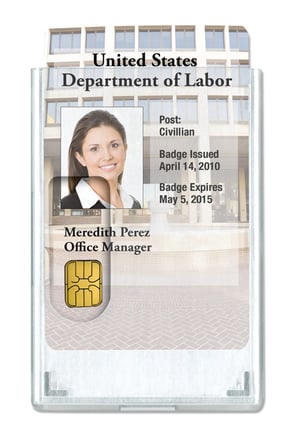- No products in the cart.
What Are Shielded Badge Holders and How Do They Work?
13
Sep
If you've been browsing our site looking for a new ID card holder, chances are you've encountered the term "shielded badge holder" at some point. And unless you're as familiar with ID products as we are, you probably had a very basic (but valid) question:
"What the heck is a shielded badge holder?"
A shielded badge holder sounds like it could be one of several things:
- Did it get that name by being the favorite ID badge holder of medieval knights?
- Is it just another name for a non-flexible badge holder?
- Maybe it's a soft badge holder coated in an outer shell, like a turtle...
In reality, shielded badge holders are none of the above. Instead, shielded badge holders serve as a pretty basic solution to a very modern problem.
What is a shielded badge holder?
A shielded badge holder is a type of ID card holder that contains a thin layer of metal. Shielded badge holders, also known as shielded card holders, can be flexible or rigid, and are available in a variety of different materials.
Shielded holders are normally used to carry a variety of types of "smart" employee badges, including MIFARE cards, iCLASS cards and a variety of US government ID credentials, including PIV cards, CACs, TWICs and FRACs.
Shielded holders normally aren't used for proximity cards or standard identification cards; instead, those use standard badge holders.
What does a shielded badge holder do?

The term "shielded" actually refers to what the metal insert is doing: it "shields" the inserted smart card from being read or scanned by card readers.
Fully understanding this requires a bit of background information on how smart cards work.
Normally, a smart card in a radio-frequency identification (RFID) program works by having an internal chip that interacts with a dedicated card reader.
The card reader contains an antenna that scans for RFID chips. When the scanning antenna picks up a chip, it takes the data from that chip and sends it back to a receiver that translates the data for use in payment systems, access control systems and more.
The thin piece of metal material that is the major part of a shielded badge holder helps to interrupt this process. The metal material helps to prevent the smart chip from being picked up by the antenna of a smart card reader.
Essentially, the metal "shields" the chip from the scanning antenna, sending the waves bouncing back and preventing the transmission of any data.
Why would you want to block an RFID card from being scanned?
It seems kind of counterintuitive, doesn't it? After all, the point of RFID cards is for them to be contactless and convenient, to allow for the quick collection of data or granting of access.
However, many of today's RFID cards can contain sensitive data. For example, an employee ID smart card used at a large corporation may contain information like the cardholder's name, title and security clearance. Even if the face of the card just features a name and a photo, a wealth of data may exist on the chip beneath the surface.
The data exists on the card so the system can use it to verify access, which is a great use of an RFID smart card; however, it isn't data you'd want out there for public consumption.
Contactless payment with credit cards is becoming an increasingly popular method of payment as well. Some of these cards use similar technology to that referenced above, potentially leaving a card vulnerable to unauthorized data access by anyone with a rogue reader.
Are people actually being victimized by this kind of data theft?
The short answer is "yes," but the extent of the damage being done is unclear. Various reports and articles have shown that it is, in fact, possible for a data thief armed with the right card reader to pick up information off of a smart card or chip-containing credit card. This kind of data theft is known as skimming, a type of identity theft mainly focused on acquiring user data.
Many credit card companies have taken steps to make the kind of information that can be gleaned from skimming essentially useless. For example, some cards issue a one-time PIN for each transaction, while others ensure that no card numbers, CVVs or names are transmitted via RFID.
However, corporations, government offices and other organizations using RFID-based smart cards may not have taken the same steps, potentially leaving their user data vulnerable. Such vulnerabilities would be particularly troubling for high-security organizations or government offices dealing in classified data or intelligence.
How can I protect a smart card from data skimming?
The simplest method, as this post has hopefully made clear, is to use a shielded badge holder.
As mentioned above, shielded badge holders contain thin layers of metal that prevent the card from being read by a scanning antenna. In the event that a data thief held a reader to your smart card, the shielded badge holder would prevent it from being read.
Shielded badge holders come with the added benefit of looking just like regular badge holders. They're available in several styles, including open-face and multi-card, as well as several materials, including paper, flexible vinyl and rigid plastic.
When using a shielded holder, you can have your card scanned for legitimate purposes by simply removing it from the holder and passing by a reader. This functionality makes shielded badge holders a great way to prevent data theft without rendering your card unusable in the process.

 USA
USA





